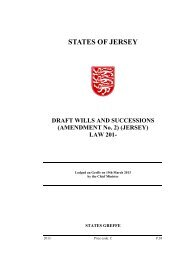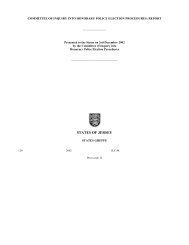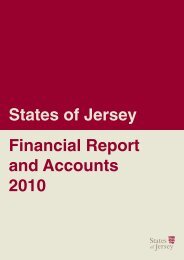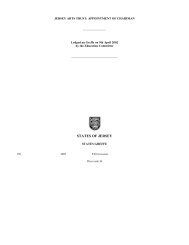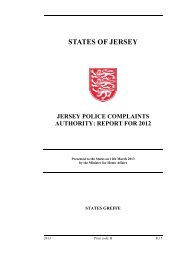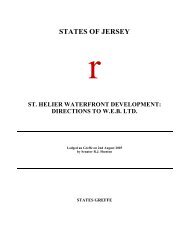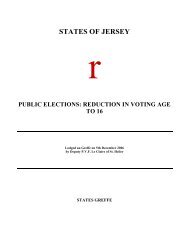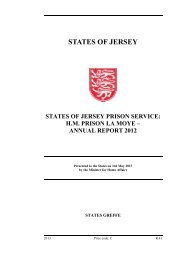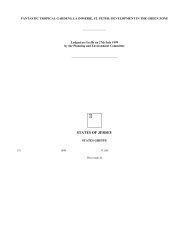Waste not want not - States Assembly
Waste not want not - States Assembly
Waste not want not - States Assembly
Create successful ePaper yourself
Turn your PDF publications into a flip-book with our unique Google optimized e-Paper software.
Figure 7: A more detailed version<br />
of the waste hierarchy<br />
<strong>Waste</strong><br />
reduction<br />
Re-use<br />
Recycling &<br />
Composting<br />
Energy recovery with<br />
heat & power<br />
Energy recovery<br />
Landfill with energy recovery<br />
Landfill<br />
Source: in Murray R. Creating Wealth from <strong>Waste</strong><br />
from work by Merrill Lynch<br />
binding tool in the same way as the <strong>Waste</strong><br />
Hierarchy in Figure 6 under the EC <strong>Waste</strong><br />
Framework Directive.<br />
Figure 8: SU version of the<br />
waste hierarchy<br />
Reduce<br />
Re-use<br />
Recycle<br />
A mixture of pretreatment<br />
and disposal<br />
options<br />
5.9 A third alternative is possible by combining<br />
the two versions in Figures 6 and 7 into Figure 8.<br />
This retains the principle of moving up the<br />
hierarchy to a reduction-re-use-recycling-led<br />
strategy but makes a clearer distinction between<br />
these options and disposal or pre-treatment<br />
options. 65 It is a clearer guide to non-waste<br />
experts and underpins the approach of the<br />
strategy set out later in this chapter and in<br />
detail in the remainder of the report, namely to<br />
aim for options in the top half of the hierarchy.<br />
It provides a helpful way of focusing on the<br />
main themes in this strategy – namely reducing,<br />
re-using and recycling waste. However, it should<br />
be stressed that it is <strong>not</strong> an accepted and legally<br />
5.10 However, it is clear that whatever the<br />
specification of the waste hierarchy, it can only<br />
be a partial guide to decision making. It shows<br />
an ordering of the options and illustrates that<br />
each step up will generate an additional<br />
environmental benefit. To be of practical use it<br />
needs to be assessed against other criteria,<br />
including costs, to reach an acceptable point on<br />
the hierarchy. This is why the principle of the<br />
BPEO is used by waste management experts at<br />
local level together with the hierarchy (see Box 7).<br />
5.11 There are cases where the BPEO for a type<br />
of waste may be some way down the hierarchy.<br />
Box 7: Best Practicable Environmental Option (BPEO)<br />
The Royal Commission on Environmental Pollution (12th Report) defined BPEO as<br />
WASTE NOT, WANT NOT<br />
“for a given set of objectives, the option that provides the most benefits or the least damage to<br />
the environment as a whole, at acceptable costs in the long term as well as in the short term.”<br />
65<br />
This does <strong>not</strong> imply that pre-treatment or other disposal options have no value, nor that all the options within the lower half have the<br />
same environmental impact<br />
44




